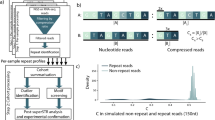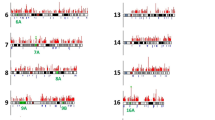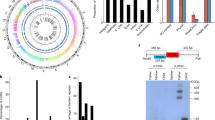Abstract
Expansion of trinucleotide repeats can give rise to genetic disease. We have developed a technique, repeat expansion detection (RED), that can identify potentially pathological repeat expansion without prior knowledge of chromosomal location. Human genomic DNA is used as a template for a two–step cycling process that generates oligonucleotide multimers when expanded trinucleotide sequences are present at the level found in myotonic dystrophy and fragile–X patients. We have identified at least one new locus exhibiting trinucleotide expansion. Analysis of three families transmitting a long CTG repeat shows that the allele in these families corresponds to a locus on chromosome 18. RED constitutes a powerful tool to identify other diseases caused by this mechanism, particularly diseases associated with anticipation.
This is a preview of subscription content, access via your institution
Access options
Subscribe to this journal
Receive 12 print issues and online access
$209.00 per year
only $17.42 per issue
Buy this article
- Purchase on SpringerLink
- Instant access to full article PDF
Prices may be subject to local taxes which are calculated during checkout
Similar content being viewed by others
References
Webb, T.P., Bundey, S.E., Thake, A.I. & Todd, J. The Frequency of the Fragile X Chromosome Among Schoolchildren in Coventry. Am. J. med. Genet. 23, 573–580 (1986).
Gustavson, K.H., Blomquist, H. & Holmgren, G. Prevalence of Fragile–X Syndrome in Mentally Retarded Children in a Swedish County. Am. J. med. Genet. 23, 581–588 (1986).
Harper, P.S. Myotonic Dystrophy, 2nd edn (W. B. Saunders, London, 1989).
Barany, F. Genetic Disease Detection and DNA Amplification Using Cloned Thermostable Ligase. Proc. natn. Acad. Sci. U.S.A. 88, 189–193 (1991).
Schalling, M. In Gene Expression in Neural Tissues. (ed. Conn, P. M.) 231–255 (Academic Press, New York, 1992).
Brook, J.D. et al. Molecular Basis of Myotonic Dystrophy: Expansion of a Trinucleotide (CTG) Repeat at the 3′ End of a Transcript Encoding a Protein Kinase Family Member. Cell 68, 799–808 (1992).
Verkerk, A.J.M.H. et al. Identification of a Gene (FMR-1) Containing a CGG Repeat Coincident with a Breakpoint Cluster Region Exhibiting Length Variation in Fragile X Syndrome. Cell 65, 905–914 (1991).
Hinds, H. et al. Tissue Specific Expression of FMR-1 Provides Evidence for a Functional Role in Fragile X Syndrome. Nature Genet. 3, 36–43 (1993).
Fu, Y.-H. et al. An Unstable Triplet Repeat in a Gene Related to Myotonic Muscular Dystrophy. Science 255, 1256–1258 (1992).
Mahadevan, M. et al. Myotonic Dystrophy Mutation: an Unstable CTG Repeat in the 3′ Untranslated Region of the Gene. Science 255, 1253–1255 (1992).
Richards, R.I. & Sutherland, G.R. Heritable Unstable DNA Sequences. Nature Genet. 1, 7–9 (1992).
La Spada, A.R., Wilson, E.M., Lubahn, D.B., Harding, A.E. & Fischbeck, K.H. Androgen Receptor Gene Mutations in X-linked Spinal and Bulbar Muscular Atrophy. Nature 352, 77–79 (1991).
Biancalana, F., Serville, F., Pommier, J., Julien, J. & Mandel, J.L. Moderate Instability of the Trinucleotide Repeat in Spino Bulbar Muscular Atrophy. Human molec. Genet. 1, 255–258 (1992).
The Huntington's disease Collaboration group. A novel gene containing a trinucleotide repeat that is expanded and unstable on Huntington's disease chromosome. Cell 72, 1–20 (1993).
Aslanidis, C. et al. Cloning of the Essential Myotonic Dystrophy Region: Mapping of the Putative Defect. Nature 355, 548–551 (1992).
Buxton, J. et al. Detection of an Unstable Fragment of DNA Specific to Individuals with Myotonic Dystrophy. Nature 355, 547–548 (1992).
Harley, H.G. et al. Expansion of an Unstable DNA Region and Phenotypic Variation in Myotonic Dystrophy. Nature 355, 545–546 (1992).
Riggins, G.J. et al. Human Genes Containing Polymorphic Trinucleotide Repeats. Nature Genet. 2, 186–191 (1992).
Beckmann, J.S. & Weber, J.L. Survey of Human and Rat Microsatellites. Genomics 12, 627–631 (1992).
Sambrook, J., Fritsch, E. & Maniatis, T. Molecular Cloning: A Laboratory Manual 3rd edn (Cold Spring Harbor Press, New York, 1989).
Author information
Authors and Affiliations
Rights and permissions
About this article
Cite this article
Schalling, M., Hudson, T., Buetow, K. et al. Direct detection of novel expanded trinucleotide repeats in the human genome. Nat Genet 4, 135–139 (1993). https://doi.org/10.1038/ng0693-135
Received:
Accepted:
Issue Date:
DOI: https://doi.org/10.1038/ng0693-135
This article is cited by
-
Spinocerebellar ataxia type 28: A novel autosomal dominant cerebellar ataxia characterized by slow progression and ophthalmoparesis
The Cerebellum (2008)
-
Bidirectional expression of the SCA8 expansion mutation: One mutation, two genes
The Cerebellum (2008)
-
A novel trinucleotide repeat expansion at chromosome 3q26.2 identified by a CAG/CTG repeat expansion detection array
Human Genetics (2006)
-
A novel CpG-associated brain-expressed candidate gene for chromosome 18q-linked bipolar disorder
Molecular Psychiatry (2003)
-
European combined analysis of the CTG18.1 and the ERDA1 CAG/CTG repeats in bipolar disorder
European Journal of Human Genetics (2002)



